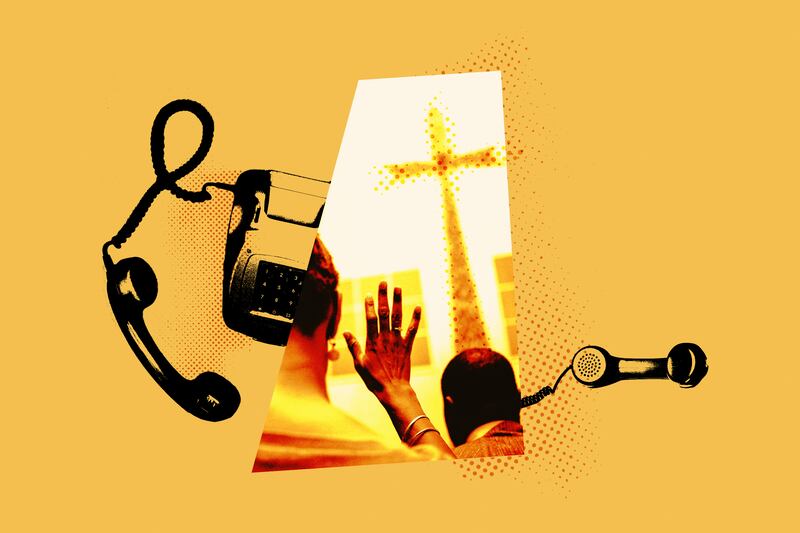I was a bit under the weather when I picked up my cellphone and dialed the Coburn, Pennsylvania, number for a sermon by phone. Leaning back in bed, I hit the speaker button. Something about listening to the service on my phone felt warmer and more intimate than watching a recording or livestream on my computer. There was nothing between me and the pastor’s upbeat voice — it’s like she was right there with me, holding my hand as she spoke.
“Welcome to worship this week,” said the Rev. Theresa Heiser, of the Penns Valley Charge of the United Methodist Church, her cadence bubbly. “It is the message for July 10, 2022, … and I’m so glad you could join us this week.”
The Rev. Heiser went on to explain that her sermon was part of a series titled “Called In.”
“Although society tells us to call people out, Jesus calls us in,” said the Rev. Heiser. “That doesn’t mean that he doesn’t address sin and error … but he goes a step further to call us into right relationships.”
She posed a question, “When we can’t trust our instinct, how does God let us know right from wrong?” adding that she hoped the question will be answered by the end of the phone sermon. Then she turned to scripture, sharing the parable of the good Samaritan.
The Rev. Heiser is just one of hundreds of pastors across the country utilizing the Sermon by Phone service that was started in May 2020 by Guy Wyant, husband of the Rev. Jennifer Wyant, associate pastor of Birmingham United Methodist Church in Milton, Georgia.
At the beginning of the COVID-19 pandemic, Wyant learned that the congregation his wife helps lead included “one or two folks who didn’t have internet access.” As he listened to her wondering aloud what she could do for these people — older folks for whom church is a lifeline — he realized that was likely a problem all across the country. He also guessed that a lot of pastors might not know how to livestream.
But the phone — everyone knows how to use that.
Wyant, who does research and development in the software department of an Atlanta-based logistics company, had the technical know-how to help. He came up with the Sermon by Phone software and launched the accompanying website.
For a small fee – just $10 a month to cover Wyant’s costs — churches can upload a sermon to the site and users can access that sermon by simply calling a local number, unique to their congregation. Since its inception, Sermon by Phone has had 217,000 calls, and callers have spent a total of 29,519 hours listening to sermons, some of which, Wyant said, run as long as an hour and a half.
While Zoom also offers a call-in feature, “I found that some folks struggled with the Zoom call-in feature and gave up,” said the Rev. Heiser. “What’s great about this service is that unlike Zoom’s call-in feature which is only open during the service time, anyone can call the sermon by phone 24/7. The message is available for a week, till the next one is loaded to the system. Some folks call more than once a week. It provides them comfort.”
Congregants in the hospital and long-term care facilities also utilized the Sermon by Phone service, said the Rev. Heiser, who added that, for some, the calls were about more than worship.
“They called up to four times a week just to hear a familiar voice and uplifting message,” she said.
Gettysburg United Methodist Church in Gettysburg, Pennsylvania, began using the service early on in the pandemic, said lay leader Larry Spear.
“There is a segment of the population that does not have access to computers. They have cellphones, they have a home phone and so forth. When we’re looking at that demographic we’re probably looking at older folks. We wanted to make sure that we had something that could be accessed by everyone who is interested,” he said.
It’s not just United Methodist pastors who are using Sermon by Phone. Leaders from other denominations are, too, including Presbyterians and some from the United Church of Christ. At least one Quaker church is using the service, as well.
While evangelical broadcasts via radio are well known, attempts to conduct worship services by phone are not. But in reality, faith-related phone and radio services rose in tandem. The earliest “sermon by phone” I found referenced online was a 1921 service conducted using a machine called a “wireless telephony” that can best be described as part phone and part radio. The pastor spoke into a phone-like component, and the sermon was broadcast by radio.
So singular was the event that it was covered by The New York Times, which estimated that the sermon reached a “congregation” of 25,000 to 130,000 listeners. Produced by Walter J. Garvey, whom the Times described as a “amateur wireless operator in the Bronx,” the sermon was preached by the Rev. Richard Jay Ward and dubbed the “Radio Church of America.”
On another occasion, in 1905, also documented by The New York Times, a hospitalized man attended his wife’s funeral services via phone.
As the COVID-19 pandemic has waned and churches have returned to in-person worship, some congregations have discontinued using Sermon by Phone. But many have kept the option, largely because it’s cheap and user-friendly.
The medium is one of the hidden blessings of the COVID-19 era, according to the Rev. Heiser. She said, “Had it not been for the pandemic, we wouldn’t have continued offering this service.”


